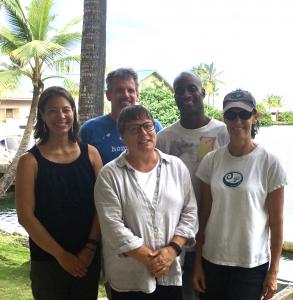UH Manoa receives funding to evaluate ocean observing technologies
University of Hawaiʻi at MānoaProfessor of Oceanography, School of Ocean and Earth Science and Technology
Marcie Grabowski, (808) 956-3151
Outreach Specialist, School of Ocean and Earth Science and Technology
As part of a national collaboration, researchers at the Hawai‘i Institute of Marine Biology (HIMB) and Department of Oceanography have been awarded over $1 million to test and evaluate the accuracy and utility of technology used to observe aquatic ecosystems. HIMB and Department of Oceanography are part of the School of Ocean and Earth Science and Technology (SOEST) at UH Manoa.
The collaboration, called Alliance for Coastal Technologies (ACT, www.act-us.info), is a component of the U.S. Integrated Ocean Observing System (IOOS®), and is funded by the National Oceanic and Atmospheric Administration (NOAA) and Environmental Protection Agency (EPA).
One of the greatest challenges that scientists and resource managers face in incorporating advanced technologies is bridging the gap between the developmental stage and operational stage of new environmental sensors and instrumentation. Efforts dedicated to maturing observing technologies to operational readiness through rigorous and relevant testing, while simultaneously building user confidence and capacity, continue to be critical.
This month, the HIMB will be the site for field testing of nutrient sensors involving sensor developers from around the world. Laboratory and field-testing will be carried out under well-understood conditions, which allow instrument manufacturers to assess and improve components, configurations and designs as necessary. The ACT evaluations provide independent assurance that basic science understanding, forecasting and management decisions are based on accurate, precise and comparable observing data, while minimizing the risks and problems associated with young technology.
HIMB Director Ruth Gates has welcomed ACT to Coconut Island. “The HIMB is uniquely situated and equipped to facilitate the rapid test and comparison of new technologies for observation of coastal ecosystems, activities that underpin decisions with national relevance,” said Gates.
This new grant also supports the mission of the Pacific Islands Ocean Observing System (PacIOOS), one of 11 IOOS regional associations. PacIOOS empowers ocean users and stakeholders in the Pacific Islands by providing accurate and reliable coastal and ocean information.
“Reliable nutrient information is an identified need of local stakeholders that would enhance our existing PacIOOS near shore water quality sensors. This is a perfect opportunity to ensure these instruments are suitable for monitoring in low nutrient environments characteristic of the region,” said PacIOOS Director Melissa Iwamoto.
“Through ACT, our goal is to assess technology that enables a holistic understanding of coastal environments, including chemical, physical and biological characteristics. The results of ACT testing will be used nationally and internationally. This grant also allows us to strengthen our partnerships locally with HIMB and PacIOOS,” said Oceanography Professor Margaret McManus, one of the principal investigators at UHM for ACT.
More about ACT
ACT was established by NOAA in 2001 to bring about fundamental changes to environmental technology innovation and research-to-operations practices. ACT is a nation-wide partnership of research institutions, resource managers, and private sector companies dedicated to fostering the development and adoption of effective and reliable sensors and platforms for use in coastal, freshwater and ocean environments. ACT’s mission is to foster the creation of new ideas, new skills, new technologies, new capabilities, and new economic opportunities in support of the sustained national IOOS. Since 2004, ACT has evaluated 65 sensors from 29 international companies. ACT is now the world’s leader in the evaluation of commercial and emerging ocean, coastal and freshwater sensing technologies.
(Full caption for group photo) In back, from left: Melissa Iwamoto, PacIOOS director; Daniel Schar, Co-PI for ACT; Gordon Walker, Oceanographic Technician for PacIOOS and ACT; and Professor Margaret McManus, Co-PI for ACT. In center is Dr. Ruth Gates, director of HIMB.

